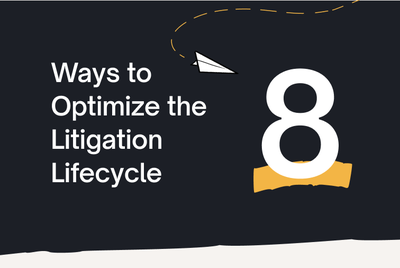8 Ways to Optimize the Litigation Timeline


The litigation lifecycle is a complex, multi-step process that can benefit significantly from optimization through the use of legal technology. Understanding each phase and how modern solutions, such as those provided by Proof, can enhance efficiency is key to streamlining this lifecycle for legal practitioners.
Through the expansion of service offerings and technological innovation, legal firms can enhance efficiency, reduce errors, and better manage their caseloads across all stages of litigation.
Here’s a breakdown of the litigation timeline and strategies for improving efficiencies at each stage:
1. Client Engagement
Activities: Lawyers perform an initial assessment, gathering information about the client’s legal issues, evaluating case viability, and assessing potential liabilities and damages.
Optimization Tip: Though this stage is lawyer-driven, using technology to enhance data collection from clients (e.g., through web-based intake forms) could streamline these efforts.
2. Investigation
Activities: Reviewing emails, files, documents, premises visitations, interviewing witnesses and document collection, which may include content such as official medical records and photographs (with metadata).
Optimization Tip: Automating medical record retrieval, using software to de-dupe and organize documents, and creating a reliable network of investigators can accelerate this phase.
3. Demand Letters and Postings
Activities: Pre-litigation communication, including demand letters or eviction notices, for matters of debt collection, loan repayment, and property management.
Optimization Tip: Automating the creation and delivery of demand letters and legal postings could enhance consistency and reduce manual efforts.
4. Case Initiation
Activities: Filing complaints and serving process (a.k.a. Service of Process or SOP). This stage is essential for proper notice to the parties involved in litigation.
Optimization Tip: Use a trusted and secure software platform that provides access to a national network of vetted process servers, real-time tracking, and automated affidavit generation to increase operational efficiencies and reduce potential errors.
5. Discovery
Activities: This includes capture of depositions (in-person, remote, hybrid, and written) and expert witness testimony, as well as a period of document exchanges and review.
Optimization Tip: Digital deposition transcription services and e-discovery platforms can drastically cut down on time and improve efficiencies, allowing for technology to do some of the heavy lifting.
6. Pre-Trial and Trial Preparation
Activities: Lawyers prepare their cases, manage relevant documents, and develop trial strategies.
Optimization Tip: Employ an integrated technology plan for your firm that helps organize documents and generate trial materials on a safe and secure platform.
7. Trial
Activities: The case is presented in court, with witness testimonies and presentation of evidence.
Optimization Tip: The domain of lawyers, the trial period can be supported by smart technologies that provide access to all relevant trial materials, support client communication, billing, scheduling, and other essential functions.
8. Post-Trial
Activities: This involves enforcing judgments, locating assets, and managing debtor relocations.
Optimization Tip: A legal technology solution can help streamline asset searches and debtor investigations resulting in successful debt recoveries.
To optimize the litigation lifecycle, paralegals, office managers, tech advisors, and attorneys should embrace technology that integrates seamlessly with other business software, safely and securely automates repetitive tasks, provides visibility into case documents and communication, and other efficiencies.
Though digital tools are essential for running a 21st-century legal practice, the importance of the human element cannot be overstated–or overlooked. Trusted, reliable contractors, such as process servers, investigators, expert witnesses, and appearance counsel are essential.
Proof is actively shaping this future by leveraging AI, developing new legal tech tools, and focusing on solving industry pain points like efficiency in high-volume practices, and we look forward to working with you.